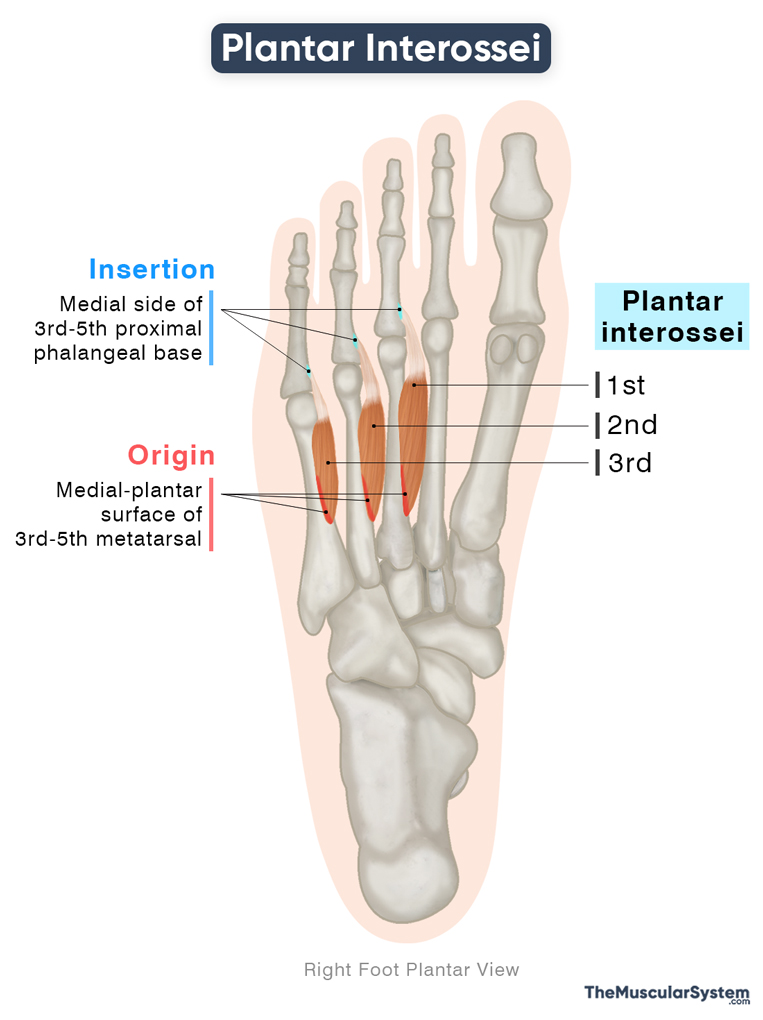Plantar Interossei
Last updated:
31/10/2025Della Barnes, an MS Anatomy graduate, blends medical research with accessible writing, simplifying complex anatomy for a better understanding and appreciation of human anatomy.
What Are the Plantar Interossei
The plantar interossei are three narrow unipennate muscles located between the third, fourth, and fifth toes. It is one of the two muscle groups that form the fourth and deepest layer of plantar muscles, with the other being the dorsal interossei.
From medial to lateral, the three muscles are numbered as the first, second, and third plantar interossei based on their location. Their actions include adduction, flexion, and extension of the three lateral toes they are associated with.
Anatomy
Location and Attachments
| Origin | Medial-plantar surface of the 3rd to 5th metatarsal |
| Insertion | Medial side of the proximal phalangeal base of the 3rd-5th toes |
Origin
The first, second, and third plantar interosseous originate from the medial side of the plantar aspect of the third, fourth, and fifth metatarsals. Unlike the bipennate dorsal interossei, which arise from both sides of the metatarsals, the plantar interossei originate from only one side, giving them their characteristic unipennate shape.
Insertion
From their origin, the muscle fibers form a narrow belly and course forward (or distally) toward the toes. They cross the third-fifth metatarsophalangeal joints on the medial side, each one narrowing into a small tendon near the head of the metatarsal bone from which they originate. Then, these tendons insert into the medial side of the third to fifth proximal phalangeal base. Some part of the tendon also inserts into the extensor hood of the corresponding toe.
From their origins, the muscle fibers form a slender belly and run forward along the sole toward the toes. They gradually narrow into three small tendons as they approach the heads of their respective metatarsal bones. Each tendon crosses the medial side of its respective metatarsophalangeal joint and inserts into the medial base of the proximal phalanx of the third, fourth, and fifth toes. Part of these tendons also insert into the extensor expansion on the dorsal surface of the same digits.
Relations With Surrounding Muscles and Structures
The plantar interosseous muscles lie deep to the muscles of the third muscular layer of the sole, the flexor hallucis brevis, adductor hallucis, and flexor digiti minimi brevis. They are covered superficially by the dorsal interossei.
As they approach their insertions, the three tendons course beneath the deep transverse metatarsal ligament. Inferiorly, the first, second, and third plantar interossei are related to the second, third, and fourth lumbricals, respectively.
Along the medial borders of the three muscles, the plantar metatarsal arteries run parallel, supplying the adjacent intermetatarsal spaces.
Function
| Action | — Flexion and abduction of the 3rd-5th toes at the metatarsophalangeal joints — Extension of the 3rd-5th toes at the interphalangeal joints |
Adduction of the Lateral Three Toes
The plantar interossei adduct the third to fifth toes toward the second toe, which serves as the midline of the foot. This adduction occurs at the metatarsophalangeal joints and helps maintain the stability and alignment of the lateral toes, preventing them from splaying apart under the body’s weight
Flexion of the Lateral Three Toes
They also flex the same toes at their metatarsophalangeal joints, contributing to the gripping action of the toes. During the push-off phase of walking or running, this flexion assists in stabilizing the forefoot and maintaining contact with the ground as the heel lifts.
Helping with Toe Extension
Through their attachment to the extensor hood, the plantar interosseous muscles extend the proximal and distal interphalangeal joints of the same toes. It helps keep the toes straight and stable as the body pushes forward during walking.
Antagonists
The dorsal interossei are antagonistic to the plantar interossei because the dorsals abduct the same toes away from the second toe, which the plantars adduct toward it. However, both work together to flex and extend the toes at their metatarsophalangeal and interphalangeal joints.
Innervation
| Nerve | Lateral plantar nerve (S2-S3) |
All three interosseous muscles are innervated by the deep branch of the lateral plantar nerve, originating from the tibial nerve, and carrying fibers from the second and third sacral nerve roots (S2-S3). The third, most lateral plantar interossei receives additional innervation from the superficial branch of the lateral plantar nerve.
Blood Supply
| Artery | Lateral plantar artery |
Blood supply to the muscle comes from the lateral plantar artery, and its branches including the deep plantar arch, and the plantar and dorsal metatarsal arteries. The lateral plantar artery itself is a branch of the posterior tibial artery.
References
- Plantar Interossei Muscles: Kenhub.com
- Plantar Interossei (Foot): TeachMeAnatomy.info
- Plantar Interossei: WheelessOnline.com
- Plantar Interossei: Meddean.LUC.edu
- Plantar Interossei Muscles (Left): Elsevier.com
Della Barnes, an MS Anatomy graduate, blends medical research with accessible writing, simplifying complex anatomy for a better understanding and appreciation of human anatomy.
- Latest Posts by Della Barnes, MS Anatomy
-
Rectus Capitis Posterior Minor
- -
Rectus Capitis Posterior Major
- -
Obliquus Capitis Inferior
- All Posts






